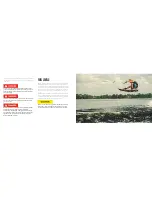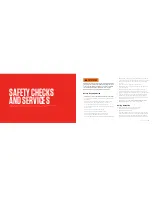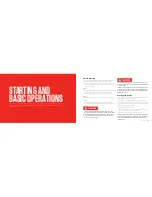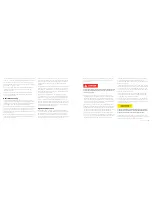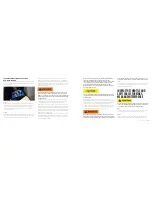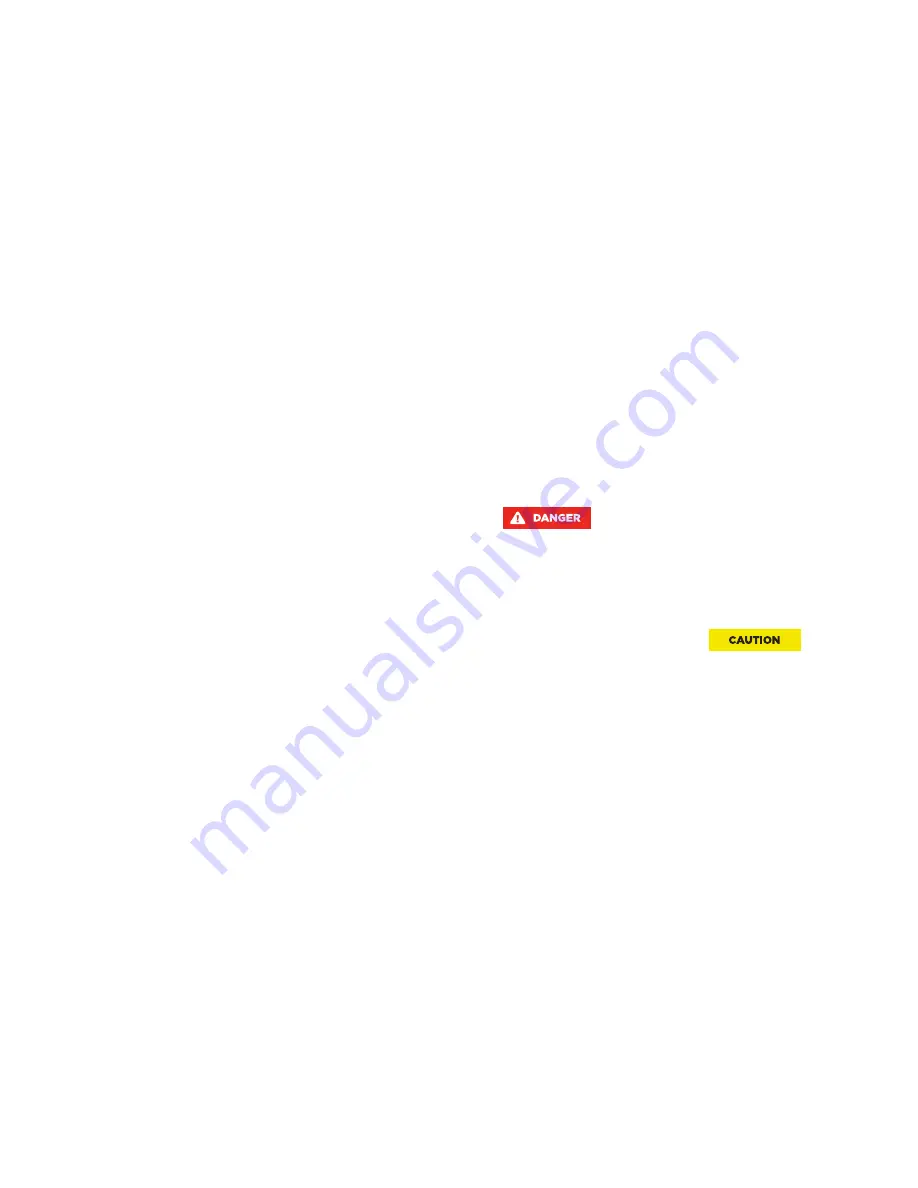
2017 OWNERS MANUAL /
334
Maneuvers of this nature could cause serious injury or death, as
well as damage to your MasterCraft boat that will not be covered
under warranty.
Boat operators should never attempt to duplicate operational skills
of professional drivers. When such maneuvers fail, it can result in
serious injury or death.
For the best engine performance and longevity, the wide-open-
throttle (WOT) engine operation must be near the top of, but within,
the specified WOT operating range. To adjust the WOT operating
range, select a propeller with the proper diameter and pitch. The
propeller supplied on the boat was chosen for best all-around per-
formance under average operating conditions.
Load, weather, altitude and boat condition all affect WOT engine
operation. If the boat is used for several different applications such
as wakeboarding, barefooting and cruising, it may be necessary to
have two (2) or more propellers of differing size and pitch to allow
the engine to operate in the WOT range for each application.
Propping the boat should be done after the boat is loaded in the
manner in which it would normally be loaded for each application. For
example, in propping the boat for wakeboarding, fill the ballast tanks
and add the people and gear that normally would be expected
Practice makes perfect! Start in calm water with no wind or current
and plenty of room until you get the feel for the boat and its controls.
Proceed slowly! Give yourself time to think, react and maneuver.
Recognize outside forces! Check the wind direction and velocity, as
well as water currents and waves.
Have a crew on hand! Have friends or family ready with fenders,
lines and a boat hook to assist you when docking, as well as
launching and loading.
Remember that a boat is not an automobile! Boats cannot be
maneuvered and stopped like a car. Boats steer from the stern
(rear) and have no brakes.
Basic Maneuvering
Steering response is dependent upon three (3) factors: rudder
position, motion and throttle. While cruising speed maneuvering is
relatively easy and takes little practice, slow-speed maneuvering is
far more difficult and requires time and practice to master.
With both steering and propulsion at the rear of the boat, the initia-
tion of a turn pushes the stern of the boat away from the direction
of the turn. The stern follows a larger turning circle than the bow.
This is especially important to remember when making maneuvers
within close quarters.
While the effects of unequal propeller thrust (torque steering), wind,
and current may not always be present, a practiced driver will use
them to his/ her advantage.
in the boat. Take the boat out and after warm-up, run it at wide-
open-throttle and note the maximum RPM. EFI engines are
equipped with RPM limiters to prevent over-revving. Take note if the
RPM limiter is activated.
If the WOT RPM is higher than the maximum RPM in your engine’s
WOT operating range, the boat is under-propped. Installing a high-
er-pitched propeller will reduce the WOT RPMs. An engine that is
over-revving may quickly experience catastrophic damage, which
will not be covered under warranty.
If the WOT RPM is lower than the minimum RPM in your engine’s
WOT operating range, the boat is over-propped. Installing a low-
er-pitched propeller will increase WOT RPMs.
An engine that is under-revving is “lugging.” This places a tremen-
dous load on the pistons, crankshaft and bearings and can cause
detonation, piston seizure and other engine damage, which will not
be covered under warranty.
Engines should always be operated within engine manufacturer
guide lines. Failure to do so may cause significant damage to the
engine and drive train and is not covered under warranty!
Elevation and weather also have a very noticeable effect on the
wide open throttle power of an engine. Since oxygen gets thinner as
elevation increases, the engine begins to starve for air.
Unequal thrust is a phenomenon shared by all single-engine, pro-
peller- driven boats. With the rudder in the straight-ahead position,
a counterclockwise rotation propeller tends to cause the boat to
drive to port when going forward, and to starboard when going
backward.
At high speed, there is compensation for this effect, so that unequal
thrust is virtually non-existent. But, at slow speed—and especially
during backing— the effect can be very pronounced. This is the
main reason that most experienced drivers approach with the dock
to the starboard side of the boat.
Stopping—or checking headway—is a technique that must be
mastered. With no brakes, reverse must be used to stop the boat.
The momentum of the boat will vary according to the load. Make it a
practice to slow to in no-wake speed before shifting into reverse.
When practicing maneuvering techniques, always do so in open wa-
ter that is free of traffic. Adequate practice may make the difference
between a pleasurable boating experience or a potentially damag-
ing (at the very least, embarrassing) one.
High Speed Operation
MasterCraft boats are designed to accommodate professional
drivers with advanced operating skills who can perform high-speed
maneuvers and turns on-a-dime. DO NOT attempt to duplicate or
simulate these feats. Paid, professional drivers log thousands of
hours on the water and carefully choreograph every move. Plans are
made in advance in the event the routine must be aborted.
Summary of Contents for NXT20 2017
Page 3: ...2017 OWNERS MANUAL SAFETY KNOWLEDGE ...
Page 27: ...2017 OWNERS MANUAL 48 2017MODEL FEATURESANDSPECS ...
Page 40: ...2017 OWNERS MANUAL 74 DASHESAND VIDEOSCREENS ...
Page 42: ...2017 OWNERS MANUAL 78 XANDXTSERIESINSTRUMENTPANEL 4 3 VIDEOSCREEN XSTARINSTRUMENTPANEL ...
Page 43: ...2017 OWNERS MANUAL 80 PROSTARINSTRUMENTPANEL NXTSERIESINSTRUMENTPANEL ...
Page 58: ...2017 OWNERS MANUAL 110 XANDXTSERIES VIDEOSCREEN OPERATIONSHV450 ...
Page 67: ...2017 OWNERS MANUAL 128 XSTAR VIDEOSCREEN OPERATIONS XSTARINSTRUMENTPANEL ...
Page 80: ...2017 OWNERS MANUAL 154 PROSTAR VIDEOSCREEN OPERATIONS ...
Page 97: ...2017 OWNERS MANUAL 188 NXT OPERATIONS ...
Page 101: ...2017 OWNERS MANUAL 196 NXT20 22 VIDEOSCREEN OPERATIONS ...
Page 107: ...2017 OWNERS MANUAL 208 BOAT OPERATIONS ...
Page 158: ...2017 OWNERS MANUAL 310 PREPARATION ...
Page 172: ...2017 OWNERS MANUAL 338 CAREAND MAINTENANCE ...
Page 204: ...2017 OWNERS MANUAL 402 TRAILERS ...





